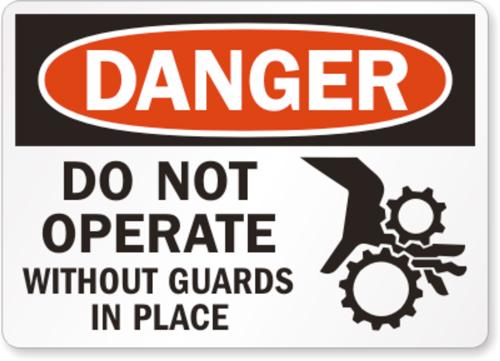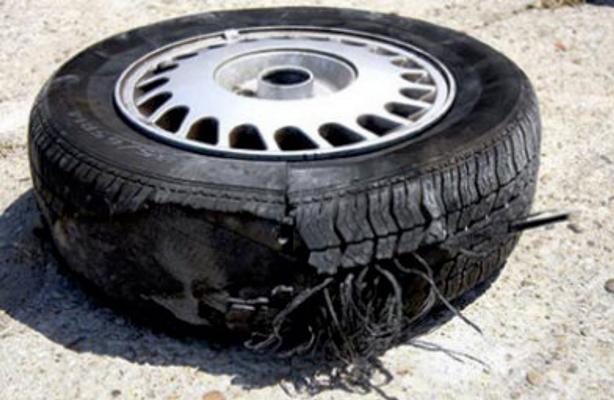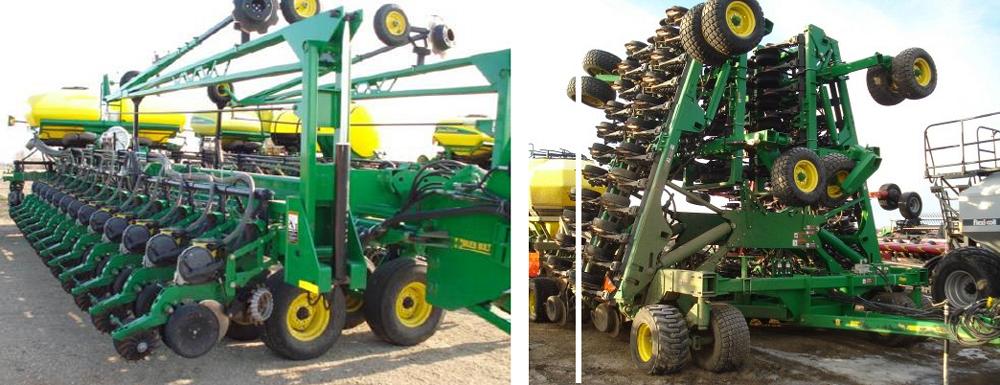- FMA
- The Fabricator
- FABTECH
- Canadian Metalworking
Categories
- Additive Manufacturing
- Aluminum Welding
- Arc Welding
- Assembly and Joining
- Automation and Robotics
- Bending and Forming
- Consumables
- Cutting and Weld Prep
- Electric Vehicles
- En Español
- Finishing
- Hydroforming
- Laser Cutting
- Laser Welding
- Machining
- Manufacturing Software
- Materials Handling
- Metals/Materials
- Oxyfuel Cutting
- Plasma Cutting
- Power Tools
- Punching and Other Holemaking
- Roll Forming
- Safety
- Sawing
- Shearing
- Shop Management
- Testing and Measuring
- Tube and Pipe Fabrication
- Tube and Pipe Production
- Waterjet Cutting
Industry Directory
Webcasts
Podcasts
FAB 40
Advertise
Subscribe
Account Login
Search
Documenting a Defense
Successfully defending a product liability lawsuit requires much more than attorneys and insurers
- By Dan D. Kohane, Harry F. Mooney, and Michael F. Perley
- May 16, 2014
- Article
- Shop Management
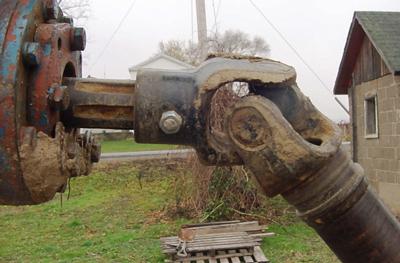
Without protective guarding, this mechanical auger linkage is an injury accident waiting to happen to an inattentive worker, and a future product liability lawsuit.
A product liability lawsuit is a possibility for any company that designs and/or manufactures a product. The number of product liability suits in the U.S. at any given time is next to impossible to discern, essentially because of the fragmentation of the legal system with its trial and appeals courts run by the 50 states (plus D.C.) and the federal government. Some cases are filed with both state and federal courts in several jurisdictions. Many cases make multiple claims of damages in addition to product liability, which further complicates tracking.
Another tracking constraint is that relatively few product liability cases go to trial. A large majority are settled (usually confidentially) or are withdrawn or dismissed. Again, no one tracks these cases on any consistent basis. Experts say the situation probably won't change until the courts adopt digital filings.
The 50-plus product liability class-action suits filed against General Motors since February 2014 illustrate the difficulty. The company is recalling about 2.6 million cars due to faulty ignition switches, a defect linked to at least 31 accidents and 13 deaths. Some (or many) of the suits that have been filed will be consolidated into a handful of large cases, and additional suits could be filed. Thus, any tally quickly becomes outdated.
Preparing to Do Battle—It's Never Too Soon
Much has been written about how engineers can avoid product liability lawsuits. Every sizable law firm in the field has lists advising its clients what to do and what not to do. Similar guidance is available from the Defense Research Institute (DRI) in Chicago.
Much less is available, however, on what engineers should do when avoidance has proven ineffective and someone has been maimed or killed. To put the question plainly, what are the steps engineers and their managers need to take when their company is sued in a product liability case, or when a suit is threatened? Herewith our advice.
A successful defense starts with rapidly visiting the scene of the accident, full disclosure of the relevant documents, and corroboration of the facts. Combined, these three steps almost always are a major asset for a defense team. It goes without saying that the first and most critically important step is to notify all of the company's liability insurance carriers. Your company's insurance premiums obligate them to defend you.
When you first learn of an actual or threatened product liability suit—even if it's just a rumor of an accident involving one of your company's products—you should do two things without delay. As with informing your insurers, you cannot afford to idly wait for a formal confirmation; that may not come for several months. The first 24 hours after learning of an injury or damaging fire or a death can be crucial to mounting a successful defense.
First, form a rapid-response team of knowledgeable people. Send this team to the accident site to take pictures immediately. Its photos and reports are your first line of defense in a product liability case. What exactly caused the accident? When and where was the accident? Were safety devices or guards removed? Were there other contributing factors? Were there witnesses?
Many insurance carriers and law firms have rapid-response units. They can be of great assistance in the immediate aftermath of any incident, sometimes securing information overlooked by emergency responders and law enforcement personnel.
Second, identify, assemble, and secure any and all relevant documents. When you defend almost any product liability (P-L) case, the documents are your friend. So is full disclosure. Withholding anything potentially relevant almost always backfires. It eventually comes to light. Your insurers will designate counsel with expertise in the area of the suit; they and your own counsel will provide guidance and insight.
Any and all means just that—no exceptions for documents that are potentially embarrassing. If there is bad P-L news for your company—a loss in a previous P-L suit, for example—get the news out early. Give your defense as much time as possible to mitigate any negative impact.
Without protective guarding, this mechanical auger linkage is an injury accident waiting to happen to an inattentive worker, and a future product liability lawsuit.
Every product liability attorney has seen a defense strategy crumble when documents that were not produced or "could not be located are pulled from a plaintiff's attorney's briefcase. This often happens in court, not just on television courtroom dramas. When it does, judges and juries rightly question the overall credibility of the defendant company and its attorneys.
Here's a painful example to drive home the point. On the eve of trial, the defendant in a product liability suit uncovered a previously undisclosed cache of product records relevant to the case. Earlier, the defendant had represented to the court it had disclosed "all material documents during the trial's discovery phase. Or so its in-house attorneys believed.
The new cache of documents was in a small warehouse that had long ago been closed, sold, and forgotten. The documents were disclosed to the court and to the attorneys for all other parties immediately. The plaintiff sought sanctions, and the court granted the motion.
The defendant's response, that its last-minute disclosure was innocent and unintentional, was stricken from the record. The court ruled that this response was prejudicial to other parties. Those parties should not have to proceed to trial without the chance to fully examine the newly disclosed documents. Nor should those parties have to accept an adjournment caused by the defendant when everyone else was ready for trial. The plaintiffs won the case.
Courtroom victories and defeats aside, surprise discoveries of potentially embarrassing documents also can undermine direct settlement negotiations and mediations. Disruption of these (often very tense) discussions can impose significant costs on the defense. The vast majority of product liability cases settle before trial. Some that do not settle, however, go to trial because the plaintiffs perceive that their case is strengthened if the defendant was "hiding a critical document. (At this point it is fair to ask, What is a document? See What's A Document?)
What's a Document?
In product liability (P-L) cases, a document is anything that bears on the issue.
Our digital age has broadened the definition of "document to electronic mail, voice mail and recorded telephone conversations; feeds and uploads to Twitter and other social media; and handwritten notes of meetings in which engineering or manufacturing decisions were made.
Also regarded as "documents are the contents of engineers' computer hard drives, including CAD files; the results of analyses done with CAE systems; simulations used to verify workplace ergonomics/safety and the performance of prototypes; bills of materials (BOMs); and paper or Mylar drawings of similar older products.
Nor is the term limited to the specifics of engineering. Materials provided to customers, for instance, may be highly relevant in a P-L defense. Examples are operator instructions and warnings, service manuals and bulletins, field upgrade information, installation guides, maintenance instructions, safety bulletins, recall notices, warranty terms—and anything else users were told.
Many P-L suits relate to what customers should have been told but were not. Classic examples include torts arising from the customer's failure to bolt down exercise machines and small machine tools. When these machines are rearranged, which is often in both gyms and factories, bolts can be very inconvenient.
These examples cover only documentation created and available in-house. Similar information from suppliers, distributors, and other hands-on business partners can be essential in winning a favorable verdict or a reasonable settlement.
In other words, in the legal profession, "document has become shorthand for evidence. Documents on 8-1/2 x 11 letter-sized paper (or the 8½ x 14 size preferred by lawyers) may constitute a small portion of what is needed for a winning defense.
In the workplace, mechanical engineers often confront P-L litigation involving manufacturing equipment such as punch presses and press brakes; machines such as rollers, lathes, and drill presses that can snag a worker's clothing; and construction equipment, such as power saws and nail guns.
In farm equipment, P-L claims often are tied to forage harvesters, combines, bailers, and augers. Some equipment designs have safety devices that either impede the operation of the machine or lack the durability to protect users during the machine's useful life. It has been our experience that when such safety devices wear out, there is little motivation to replace them.
Dealing With Embarrassing Documents
It is common in P-L cases to hear discussions about ferreting out evidence—discovery—of potentially embarrassing documents. This could be documentation of a prototype failure, a service bulletin issued without any general notification, or a recall and replacement. If the awkward information is known in advance, the defense can minimize the impact with explanations that stand up to scrutiny.
Plaintiff attorneys also have discovery challenges. Their challenges include evidence of negligence by the injured party, such as being warned in writing for failure to observe and heed appropriately displayed warnings, or other prior disciplinary actions. Evidence of substance abuse, such as a failed drug test or a drunk driving arrest, is always problematical for plaintiffs.
This broken chain link is a classic example of a product liability problem. Image is generic.
Bear in mind that documents appearing at first glance to be innocuous may be shown otherwise in court. If the plaintiff's attorneys surprise the court and jury with such a document, your counsel and your company could be put in an awkward position. Some potentially negative information is exempt from disclosure rules, or privileged, and can be kept out of court entirely. But the definition of "privileged is elastic and within the discretion of the court.
Showing Compassion
Compassion also is part of a good defense. Express sincere condolences to the injured and to family members if there has been a maiming or death. However, you should exercise extreme caution in making offers of compromise without the consent of your insurer; your company's coverage may be jeopardized.
This blown tire is another classic example of a product liability problem. Image is generic.
Investigating and Corroborating
Do not overlook corroboration. In court and in settlement negotiations, documents do not exist in a vacuum. They need corroboration, which means you have to investigate broadly and deeply. Be prepared to help explain and refute anything the plaintiffs may have. Meet with fire marshals and other safety officials. Check in with experts in your industry.
Do not overlook any former employees and retirees who might have direct knowledge of the facts that are pertinent to the case. Track them down, meet with them as quickly as possible, and obtain recorded statements documenting their testimony. Plaintiff attorneys will do the same.
One or more former employees may be hostile to your company, for example, someone who feels he or she was fired unjustly. See if anything can be done to mollify them, and thereby reduce any harm they might do in court if they testify for the plaintiffs.
Dealing With the Media
If the media is drawn into the case, it's almost never good for the defense. The potential for media involvement makes it critical that you get your arms around the situation before it spirals out of control. Obviously, you should express concern for any injured individuals and point out that you are thoroughly investigating the accident.
Beyond these declarations, however, concrete statements of your opinions about the situation are almost always counterproductive. Keep all communication with the media general in nature.
It is not only in Perry Mason courtroom dramas that key pieces of evidence disappear. When this happens in real life, the defense may be at a severe disadvantage. It will be left with nothing but what the plaintiffs and the media have. The longer and more completely plaintiff attorneys control the evidence—the facts of the case—the harder it will be to mount a successful defense. This is the second fundamental reason to alert your P-L insurance carrier immediately—to give them as much time as possible to mobilize their resources for your benefit.
Hunkering and Hiding
Conversely, "hunkering down till it all blows over is never a viable strategy. If you try to hide, plaintiff attorneys have enormous financial incentives to find you, and they will. The longer your insurers are kept in the dark, the less help they will be in your defense. (See Protecting Your Liability Coverage.)
Protecting Your Liability Coverage
In defending product liability (P-L) suits, attorneys focus intensely on helping engineering companies protect their assets and helping individual engineers protect their professional reputations, which once lost are irretrievable.

Farm machinery mechanisms such as these are often driven by chains, sprockets, belts and pulleys. Any one of these mechanisms could injure a worker whether or not maintenance was a factor. Images courtesy of CuriousFarmer
There are many ways to achieve these protections, but few are more important than the company's liability insurance coverage, which is a vital asset. Coverage can easily be lost (and often is) by failing to provide proper notice of accidents, claims, and lawsuits, as well as failing to notify insurers of the circumstances that may give rise to claims before the expiration of a claims-made policy period.
Do not delay in contacting your P-L insurance company about the hint of a suit; it needs time to bring its own experts and resources to bear. Such a delay can be a financial disaster. Your company could end up paying out hard-earned assets to your defense attorneys. And if they don't prevail, far more assets may go to satisfy a judgment.
It is important to understand that liability insurance is really litigation insurance—an asset that must be guarded like any other. Miss a claims deadline and your insurance company may be off the hook. Unfortunately, many engineering and manufacturing companies fail to realize the consequences until it is too late, after the claims-made policy period expires.
When there is a P-L risk, deadlines for claims in policies are one of the most important things engineers and managers need to know. Surprisingly, amid all the P-L advice articles that circulate, the limitations of claims-made policy periods are almost never addressed.
In a more technical vein, depending on the claim, the defendant company's malpractice (errors and omissions) insurer should be notified promptly. If the claim arises out of ordinary business negligence (rather than a professional's negligence, for example), then the providers of general liability coverage must be notified. In either case, the carriers of the company's excess, or umbrella coverage, must be notified as well. A failure to promptly notify the correct insurer can lead to a loss of coverage.
Hanging on to Documents
The importance of documents can't be stressed enough. Engineering managers and in-house counsel should take a thorough look at policies on destroying old documents. Many companies destroy almost all documents more than seven years old. Seven years is merely an Internal Revenue Service rule of thumb and bears no relation to the useful life of any product.
Because long-term storage of paper documents can seriously affect the bottom lines of small companies, electronic data storage is the preferred method. It reduces your cost and allows you to preserve documents as long as necessary to satisfy the court in the event of litigation.
More technically, appropriate storage protocols can protect you from a court sanction for the improper destruction of a relevant document, or "spoliation. Spoliation sanctions may include a "negative inference ruling from the judge—an assertion that the destroyed document supports the plaintiff's position rather than your company's. The ultimate court sanction is striking your response, which can place your company in default and allow a judgment to be entered against it.
To summarize, rely on basic common sense in following the advice outlined here. This means being alert to potential claims against your company. And this means not waiting until you have been officially notified of a suit, because formal notification may arrive too late to mount an effective defense. Many product liability defenses succeed because of rapid response, complete documentation, and the corroboration of the documents that support the defense.
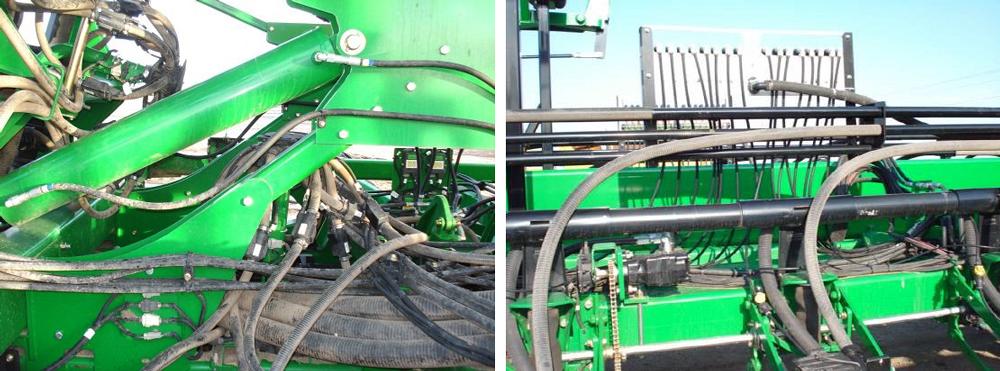
The complex innards and multiplicity of sharp-edged tools in commonly used farm equipment such as these could play a part in injuries caused by inattention or poor maintenance. Images courtesy of Farm-Connection.com
The matter doesn't end when the case is resolved and any damages awarded. Engineers can expect to be called upon to help negotiate regulatory settlements, offset negative publicity, manage product recalls, and redesign those products' replacements. More ominous consequences for the company may include a run on the company's stock and loss of bonuses and incentives as share prices decline; a possible brain drain; a takeover; or, in an extreme case, a bankruptcy.
A Corporate Response
Engineering and manufacturing companies follow very specific procedures in regards to product liability (P-L).
These procedures are spelled out by the International Organization for Standardization (ISO) and are part of the training of any new engineer or product designer regardless of their previous experience. Beyond that fundamental training requirement, however, there seem to be no guidelines.
A company's P-L procedure usually is specific to its products, determined by the capabilities of its information technology organizations, the preferences and experience of its legal staff, and the many different ways it communicates with its users.
About the Authors
subscribe now

The Fabricator is North America's leading magazine for the metal forming and fabricating industry. The magazine delivers the news, technical articles, and case histories that enable fabricators to do their jobs more efficiently. The Fabricator has served the industry since 1970.
start your free subscription- Stay connected from anywhere

Easily access valuable industry resources now with full access to the digital edition of The Fabricator.

Easily access valuable industry resources now with full access to the digital edition of The Welder.

Easily access valuable industry resources now with full access to the digital edition of The Tube and Pipe Journal.
- Podcasting
- Podcast:
- The Fabricator Podcast
- Published:
- 04/16/2024
- Running Time:
- 63:29
In this episode of The Fabricator Podcast, Caleb Chamberlain, co-founder and CEO of OSH Cut, discusses his company’s...
- Trending Articles
AI, machine learning, and the future of metal fabrication

Employee ownership: The best way to ensure engagement

Dynamic Metal blossoms with each passing year

Steel industry reacts to Nucor’s new weekly published HRC price

Metal fabrication management: A guide for new supervisors

- Industry Events
16th Annual Safety Conference
- April 30 - May 1, 2024
- Elgin,
Pipe and Tube Conference
- May 21 - 22, 2024
- Omaha, NE
World-Class Roll Forming Workshop
- June 5 - 6, 2024
- Louisville, KY
Advanced Laser Application Workshop
- June 25 - 27, 2024
- Novi, MI

























